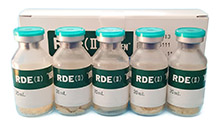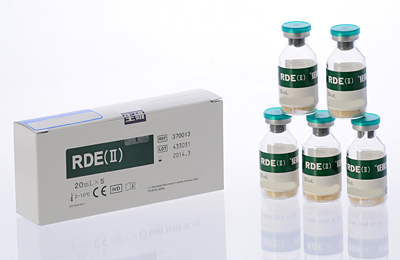The Cosmos Biomedical Receptor Destroying Enzyme (RDE) kit is produced to assist in the serodiagnosis of the influenza virus.
Our Receptor Destroying Enzyme (RDE) Kit eliminates non-specific inhibitors in human serum during serodiagnosis using the HI test for influenza virus by the action of the Receptor Destroying Enzyme. Our RDE is isolated from Vibrio cholerae Ogawa 558 to give high quality and reliable results.
Product Code: CB50/340122 Contact us now to order RDE Kits


Elimination of the inhibitors in human serum during a serodiagnosis test (Hemagglutination test: HI test) of the influenza virus.
RDE is used in the HI test for the influzena virus in order to eliminate non-specific hemagglutination inhibitors existing in a serum specimen by using An RDE (Receptor Destroying Enzyme) produced from Vibrio cholerae serovar Ogawa strain 558.
Final diagnosis should be made based on clinical symptoms, and the results of other assays. Do not use human serum with RDE for Serodiagnosis of the mumps or parainfluenza viruses since it may result in destruction of some of the antibodies contained in the serum. RDE should not be used for purposes other than the intended use described above.
The RDE should be used immediately after it has been dissolved in the physiological saline. If the dissolved solution has to be used at a latter date, store by freezing at -20°C or lower. NOTE: the freeze/thaw procedure should only be performed once. All samples should be treated as potentially infectious, and should be handled with care, with all necessary precautions taken. Used containers should not be used for any purpose. Use a water bath in the heating process described in 'Test Procedures', and keep at a constant temperature of 56°C. When handling the product ALWAYS wear gloves, eye protection, and a mask. Avoid ingestion of the reagents. If the reagent comes into contact with the skin, or eyes flush with copious amounts of water. If in any doubt consult a physician.
All specimens, used containers, and equipment used for the analysis should be treated accordingly to either methods (1) or (2) described below, and then disposed of according to the appropriate waste handling regulations. Soak in 0.5 w/v% sodium hypochlorite (effective chloride: 5,000ppm) for a minimum of 1 hour. Autoclave at 121°C for a minimum of 20 minutes.
Human Serum
Completely dissolve the product in 20mL of sterile physiological saline. This solution should be used immediately.
The performance of RDE can be verified by using the method detailed below:
Store at 2°C to 10°C protected from light.
Do not use this product beyond the expiry date
Lennette, E H. & Schmidt, NJ.,:Hemagglitination inhibition test, Diagnostic Procedures for Viral, Rickettsial and Chlamydial infections, 5th ed. Am. Pub. Hith. Assn. 603 (1979)